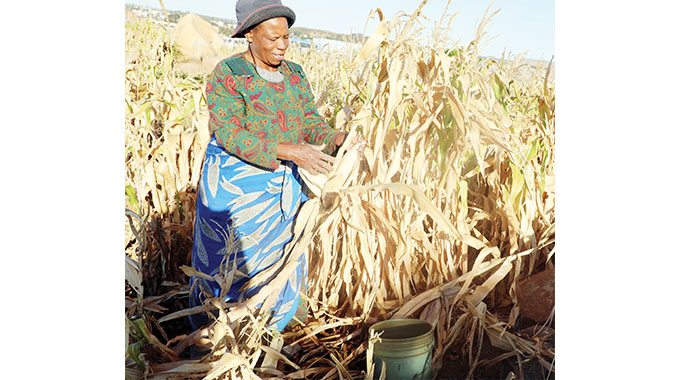
Mashudu Netsianda, Senior Reporter
FARMERS in the Matabeleland region, which has over the years been largely characterised by low rainfall and poor yields, are expecting to harvest enough maize and traditional grains to last more than 12 months.
Overall, all districts across the country have no deficit but there are some wards within the districts where some families might not harvest enough due to several reasons.
The rainfall for the 2020/21season started in early November for most provinces.
According to the latest Crop and Livestock Assessment report issued by the Ministry of Lands, Agriculture, Fisheries, Water and Rural Resettlement, in Matabeleland South province farmers from Bulilima, Gwanda, Insiza, Matobo and Umzingwane are expected to harvest maize and traditional grains which will last more than 12 months.
Beitbridge district has maize and traditional grains sufficient to last 10 to12 months while Mangwe will have supplies lasting between seven to nine months.

In Matabeleland North Province, all districts save for Hwange are set to have enough maize and traditional grains supplies lasting for more than 12 months. Hwange district has maize and traditional grains to last between 10 to12 months.
In the Midlands, Gweru district has maize and traditional grains to last four to six months while Shurugwi and Mberengwa have maize and traditional grains to last 10 to 12 months. The rest have enough supplies for more than a year.
The report states that Masvingo, Gutu and Chiredzi will have maize and traditional grains to cater for more than 12 months while Bikita, Masvingo, Mwenezi and Zaka will have grain to last between 10 to12 months. Chivi and some parts of Chiredzi has grain to last four to six months.
Most districts in all the three Mashonaland provinces have enough maize and traditional grains supplies to last more than 12 months. Mhondoro-Ngezi in Mashonaland West and Mudzi in Mashonaland East have enough grain to last between 10 to12 months.
In Manicaland Province, all districts except Buhera will get supplies to last more than 12 months. Buhera’s harvest will last between 10 and12 months.
The report states that estimated maize production for the 2020/21 season stands at about 2,7 million tonnes.
“The good harvest is attributed to an increase in the amount of rainfall received, which was well distributed throughout the season, increase in the area under climate proofed technologies and initiatives such as Pfumvudza/Intwasa,” read the report.
National maize production is dominated by the communal sector contributing 36 percent. Yield levels are however low compared to other sectors. In terms of production, Matabeleland South is set to harvest 84 923 tonnes, a sharp increase compared to 25 833 tonnes in the 2019/20 season.

Nobesuthu Ncube checking for remaining cobs from a stack of maize stalks in Lobengula West suburb, Bulawayo yesterday
Matabeleland North’s maize production stands at 115 240 tonnes compared to last season’s 20 002 tonnes.
A total of 202 037 hectares was put under Pfumvudza maize and 1 066 755 tonnes are expected from that while 50 016 tonnes of sorghum are expected from the 10 634 hectares put under Pfumvudza/Intwasa. “The maize yield for the 2020/2021 season is the highest since the 200/2001 season. The overriding factor is the amount of rainfall and distribution. In addition to the good rainfall season in the 2020/2021 season, the practice of climate proofed technologies (Pfumvudza/ Intwasa) significantly contributed to the increased yield levels supported by well-coordinated input programmes,” read the report.
Traditional grains production for the season is estimated at 347 968 tonnes compared 152 515 tonnes harvested in 2019/2020. The increase in production has also been attributed to the amount of rainfall and its distribution. — @mashnets.
